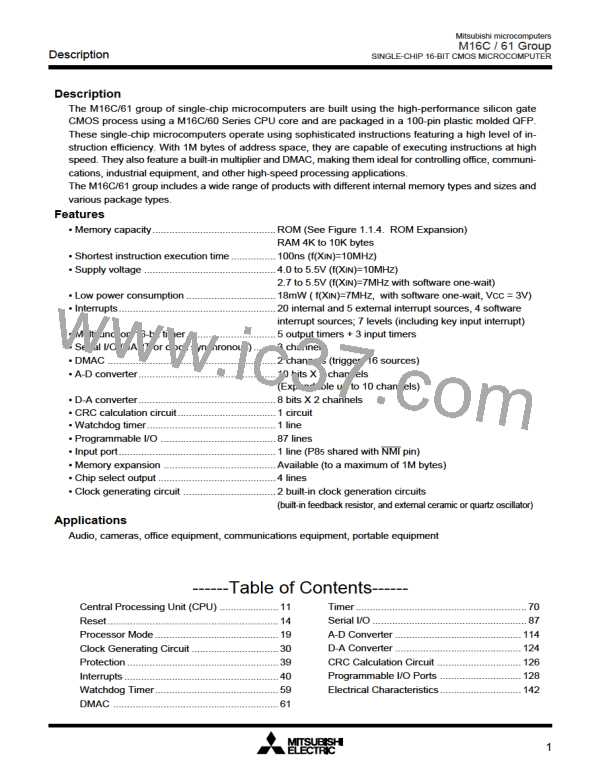Mitsubishi microcomputers
M16C / 61 Group
SINGLE-CHIP 16-BIT CMOS MICROCOMPUTER
Timer A
(4) Pulse width modulation (PWM) mode
In this mode, the timer outputs pulses of a given width in succession. (See Table 1.16.5.) In this mode, the counter functions
as either a 16-bit pulse width modulator or an 8-bit pulse width modulator. Figure 1.16.10 shows the configuration of the
timer Ai mode register in pulse width modulation mode. Figure 1.16.11 shows an example of how a 16-bit pulse width
modulator operates. Figure 1.16.12 shows an example of how an 8-bit pulse width modulator operates.
Table 1.16.5. Timer specifications in pulse width modulation mode
Item
Count source
Count operation
Specification
f1, f8, f32, fC32
• The timer counts down (operating as an 8-bit or a 16-bit pulse width modulator)
The timer reloads a new count at a rising edge of PWM pulse and continues counting
•
• The timer is not affected by a trigger that occurs when counting
16-bit PWM
• High level width
n / fi n : Set value
- 1) / fi fixed
16
• Cycle time
(2
8-bit PWM
•
•
High level width n X (m+1) / fi n : values set to timer Ai register’s high-order address
Cycle time (28 - 1) X (m +1) / fim : values set to timer Ai register’s low-order address
Count start condition
• External trigger is input
• The timer overflows
• The count start flag is set (= 1)
• The count start flag is reset (= 0)
Count stop condition
Interrupt request generation timing PWM pulse goes “L”
TAiIN pin function
TAiOUT pin function
Read from timer
Write to timer
Programmable I/O port or trigger input
Pulse output
When timer Ai register is read, it indicates an indeterminate value
• When counting stopped
When a value is written to timer Ai register, it is written to both reload
register and counter
• When counting in progress
When a value is written to timer Ai register, it is written to only reload register
(Transferred to counter at next reload time)
Timer Ai mode register
b7 b6 b5 b4 b3 b2 b1 b0
Symbol
Address
When reset
0016
1
1 1
TAiMR(i=0 to 4) 039616 to 039A16
R W
Bit symbol
Bit name
Function
b1 b0
TMOD0
TMOD1
MR0
Operation mode
select bit
1 1 : PWM mode
1 (Must always be fixed to “1” in PWM mode)
External trigger select
MR1
0: Falling edge of TAiIN pin's input signal (Note 2)
bit (Note 1)
1: Rising edge of TAiIN pin's input signal (Note 2)
MR2
Trigger select bit
0: Count start flag is valid
1: Selected by event/trigger select register
0: Functions as a 16-bit pulse width modulator
1: Functions as an 8-bit pulse width modulator
16/8-bit PWM mode
select bit
MR3
b7 b6
TCK0
TCK1
Count source select bit
0 0 : f
0 1 : f
1 0 : f32
1 1 : fC32
1
8
Note 1: Valid only when the TAiIN pin is selected by the event/trigger select bit
(addresses 038216 and 038316). If timer overflow is selected, this bit can be “1” or “0
Note 2: Set the corresponding port direction register to “0”.
Figure 1.16.10. Configuration of timer Ai mode register in pulse width modulation mode
79

 MITSUBISHI [ Mitsubishi Group ]
MITSUBISHI [ Mitsubishi Group ]